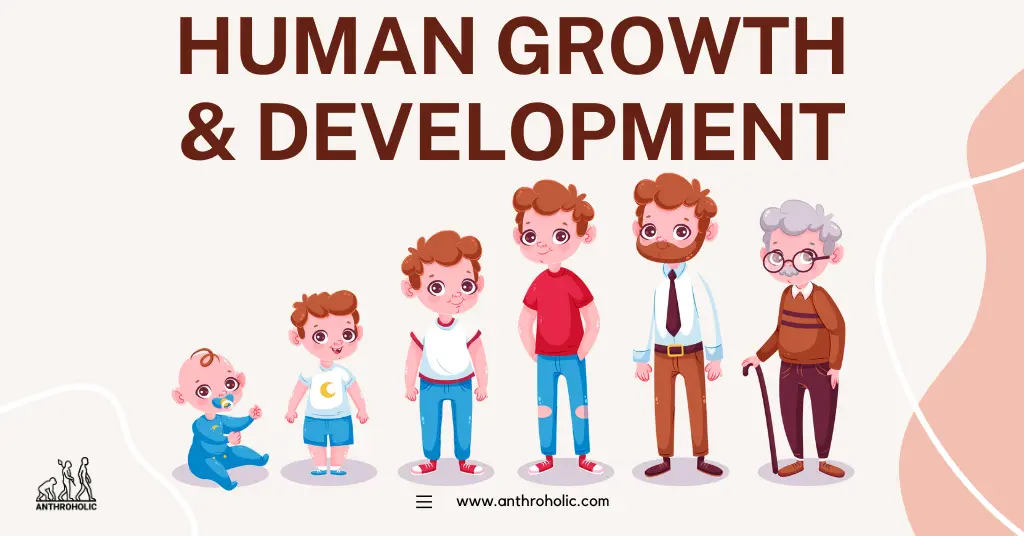AI Answer Evaluation Platform Live Now. Try Free Answer Evaluation Now
Human Growth and Development
Human growth and development is a complex, multidimensional phenomenon which involves the progressive changes in size, shape, function, and behavior that occur from conception to adulthood. From an anthropological perspective, these changes are viewed not only through the lens of biological evolution but also through cultural, social, and environmental influences [1].

Biological Perspective of Growth and Development
Stages of Human Growth
Understanding growth patterns helps in comprehending the development trajectory of an individual. Human growth stages typically follow this sequence:
- Prenatal: from conception to birth.
- Infancy: birth to 2 years.
- Childhood: 2-12 years.
- Adolescence: 12-20 years.
- Adulthood: 20 years onward [2].
A tabular representation of the characteristics of these stages is as follows:
| Stage | Characteristics |
|---|---|
| Prenatal | Rapid cell division and differentiation, formation of major organs |
| Infancy | Rapid physical growth, development of motor skills, early cognitive development |
| Childhood | Steady growth, development of language, social interaction, and complex motor skills |
| Adolescence | Rapid growth and development, onset of puberty, development of complex cognitive functions |
| Adulthood | Maintenance of physical and cognitive functions, gradual aging and related changes [3] |
Biological Factors in Growth
Biological determinants of growth include genetics, nutrition, and health status. Anthropologists study the role of these factors in different ethnic and geographic populations, shedding light on genetic influences and adaptations to environmental conditions [4].
Cultural and Social Perspectives of Growth and Development
Culture and society greatly influence human growth and development, affecting behavior, cognition, and emotional development.
Cultural Practices and Beliefs
Various cultural practices and beliefs can impact growth and development. For instance, dietary restrictions based on cultural norms can affect nutritional intake, which, in turn, influences physical growth. Anthropologists seek to understand these culturally influenced patterns and their implications [5].
Social Interactions
Social interactions play a crucial role in cognitive and emotional development. Anthropological research often explores social norms and values, and how they shape individual and group behaviors [6].
Environmental Impact on Human Growth and Development
Physical Environment
The physical environment, including climate, altitude, and exposure to sunlight, can significantly influence human growth and development. For instance, high-altitude populations have evolved to exhibit certain physiological adaptations.
Socio-Economic Environment
Socio-economic conditions, such as poverty, education, and healthcare access, also significantly influence growth and development. These environmental factors often intersect with cultural and social factors, forming a complex web that anthropologists strive to unravel.
Application of Anthropological Research in Human Growth and Development
By integrating biological, cultural, social, and environmental perspectives, anthropological research significantly contributes to a wide range of fields, including healthcare, education, policy-making, and community development.
Healthcare
Anthropological research provides insights into biological variations across different populations, informing healthcare professionals about the need for personalized medicine. This research also helps in understanding the impact of cultural beliefs and social norms on health-related behaviors and healthcare utilization.
Education
Understanding the developmental stages of a child aids in creating effective educational practices and learning environments. Anthropologists also help to comprehend how cultural and societal norms influence learning and educational attainment.
Public Policy
The understanding of growth and development through an anthropological lens can significantly inform public policy. Policies on nutrition, health, education, and social welfare are more effective when they consider the complex interplay of biological, cultural, social, and environmental factors that anthropological research elucidates.
Community Development
Anthropological research can contribute to the design and implementation of community development programs. Understanding local customs, social structures, and environmental factors can help tailor interventions to community needs and foster sustainable development.
Future Perspectives
The field of anthropological research in human growth and development continues to evolve, with new methodologies and interdisciplinary collaborations expanding our understanding of this complex phenomenon.
Genomic research, for example, can provide deep insights into the genetic basis of human growth and development. It opens doors to personalized healthcare and the potential for interventions at the genetic level.
Big data and AI technologies have the potential to significantly augment anthropological research. Large-scale data collection and analysis can identify patterns and trends that may not be apparent in smaller studies, providing a more comprehensive view of human growth and development.
Concluding Remarks
Human growth and development is a beautifully complex process shaped by a myriad of biological, cultural, social, and environmental factors. Through anthropological research, we can decode this intricate web of influences, enriching our understanding of the human condition and enabling us to create interventions that respect and harness our diversity for collective advancement. The future of this research is promising, with new technologies and methodologies poised to further deepen our knowledge and expand its applications.
References
[1] Ingold, T. (2004). “Culture and the perception of the environment”. In: Ingold, T. (ed.) Evolution and Social Life. Routledge.
[2] Tanner, J. M. (1989). “Foetus into Man: Physical Growth from Conception to Maturity”. Harvard University Press.
[3] Lerner, R. M. (2002). “Concepts and theories of human development”. Psychology Press.
[4] Bogin, B. (1999). “Patterns of Human Growth”. Cambridge University Press.
[5] DeLoache, J., & Gottlieb, A. (2000). “A World of Babies: Imagined Childcare Guides for Seven Societies”. Cambridge University Press.
[6] Rogoff, B. (2003). “The Cultural Nature of Human Development”. Oxford University Press.




